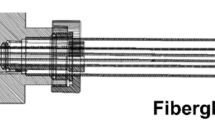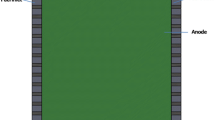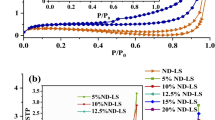It is shown that the carbon layer formed on the catalytic surface of a metal plays an important role in industrial technologies of obtaining carbon nanofibers. The effective heat conduction of porous carbon samples was measured. A mathematical model of the heat and mass transfer inside a carbon layer has been developed and its stationary solutions were investigated. It is shown that a decrease in the thickness of a porous carbon layer on the surface of a metal as a result of its cleaning and a further growth of this layer lead to the formation of a supersaturated solid solution of carbon in the metal.
Similar content being viewed by others

References
C. J. Verissimo, M. R. Aguiar, and S. A. Moshkalev, Formation of catalyst nanoparticles and nucleation of carbon nanotubes in chemical vapor deposition, J. Nanosci. Nanotechnol., 8, 1–8 (2008).
V. Labunov, B. Shulitski, A. Prudnikava, and A. Basaev, Multi-level composite nanostructures based on the arrays of vertically aligned carbon nanotubes and planar graphite layers, Phys. Status Solidi A, 208, No. 2, 453–458 (2011).
S. P. Fisenko and F. N. Borovik, Nucleation in a catalytic nanodroplet and growth of nanowires, Tech. Phys., 54, No. 9, 246–252 (2009).
S. A. Zhdanok, V. V. Martynenko, S. P. Fisenko, et al., Coalescence and the initial stage of formation of nanofibers by the "vapor–liquid–solid" scheme, Inzh.-Fiz. Zh., 83, No. 3, 417–420 (2010).
C. E. Baddour, F. Fadlallah, D. Nasuhoglu, et al., A simple thermal CVD method for carbon nanotube synthesis on stainless steel 304 without the addition of an external catalyst, Carbon, 47, 313–347 (2008).
S. A. Zhdanok, I. F. Buyakov, A. V. Krauklis, et al., On the formation of carbon nanostructures on the steel surface of a reactor as a result of the decomposition of hydrocarbons in the low-temperature plasma. 1. Experimental setup. Determination of basic mechanisms, estimation of the production rate, Inzh.-Fiz. Zh., 82, No. 3, 413–419 (2009).
S. P. Fisenko, B. N. Bazylev, and H. Wuerz, High-temperature deposition of carbon films, J. Eng. Phys. Thermophys., 76, No. 4, 743–747 (2003).
Y. A. Baranyshin, S. P. Fisenko, and O. G. Penyazkov, Heat transfer and growth of nano- and submicron particles of black carbon in nonequilibrium gas mixture. Experiment and simulation, Int. J. Heat Mass Transfer, 53, issue 23/24, 5465–5471 (2010).
Z. A. Mansurov, Formation of soot from polycyclic aromatic hydrocarbons as well as fullerenes and carbon nanotubes in the combustion of hydrocarbon, Inzh.-Fiz. Zh., 84, No. 1, 116–149 (2011).
L. E. Evseeva and S. A. Tanaeva, Thermal conductivity of micro- and nanostructural epoxide composites at low temperatures, Mekh. Kompozit. Mater., 44, No. 1, 117–126 (2008).
M. E. Kompan, F. M. Kompan, P. V. Gladkikh, et al., Thermal conductivity of a composite medium with dispersed graphene filler, Zh. Tekh. Fiz., 81, No. 8, 15–19 (2011).
N. V. Pavlyukevich, Introduction to the Theory of Heat and Mass Transfer in Porous Media [in Russian], ITMO im. A. V. Lykova NAN Belarusi, Minsk (2002).
G. A. Baker, Jr. and P. Graves-Morris, Pade Approximants, Addition-Wesley, London (1981).
R. C. Reid, J. Prausnitz, and T. K. Sherwood, The Properties of Gases and Liquids [Russian translation], Khimiya, Leningrad (1982).
V. A. Kurbatov and S. P. Fisenko, Calculation of thermal conductivities of ternary gas mixtures, J. Eng. Phys. Thermophys., 66, No. 3, 295–298 (1994).
N. N. Kalitkin, Numerical Methods [in Russian], Nauka, Moscow (1978).
V. P. Krainov, Qualitative Methods in Physical Kinetics and Hydrodynamics, American Institute of Physics, New York (1992).
D. A. Takopulo and S. P. Fisenko, On formation of carbon clusters on a substrate in plasma pyrolysis of hydrocarbon gases, Inzh.-Fiz. Zh., 84, No. 5, 1004–1007 (2011).
S. P. Fisenko, F. N. Borovik, and S. A. Zhdanok, A method of obtaining carbon nanofibers, Patent 14051 of the Republic of Belarus, Published 28.02.2011, Byull. No. 1, p. 98.
S. A. Zhdanok, K. O. Borisevich, M. V. Kiyashko, et al., On the conditions of formation of carbon nanostructures on the steel reactor surface from the products of hydrocarbon decomposition in a low-temperature plasma. 3. Depth analysis of the material, hypothesis of the growth mechanism, Inzh.-Fiz. Zh., 84, No. 3, 491–497 (2011).
Author information
Authors and Affiliations
Corresponding author
Additional information
Translated from Inzhenerno-Fizicheskii Zhurnal, Vol. 85, No. 3, pp. 503–511, May–June, 2012.
Rights and permissions
About this article
Cite this article
Takopulo, D.A., Fisenko, S.P. Heat and mass transfer in the system hydrocarbon gas–porous carbon layer–metal and formation of supersaturated solid carbon solutions. J Eng Phys Thermophy 85, 539–548 (2012). https://doi.org/10.1007/s10891-012-0684-z
Received:
Published:
Issue Date:
DOI: https://doi.org/10.1007/s10891-012-0684-z



